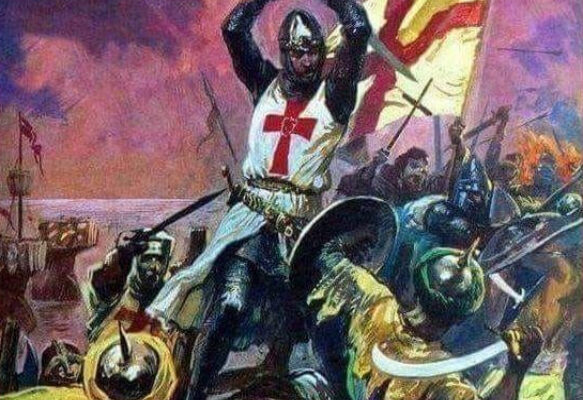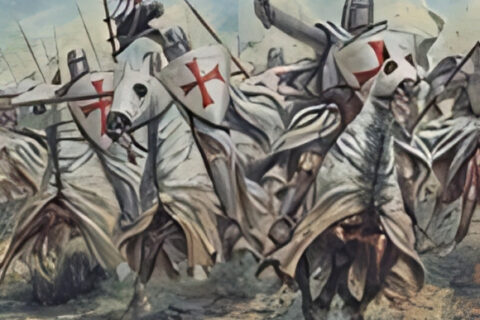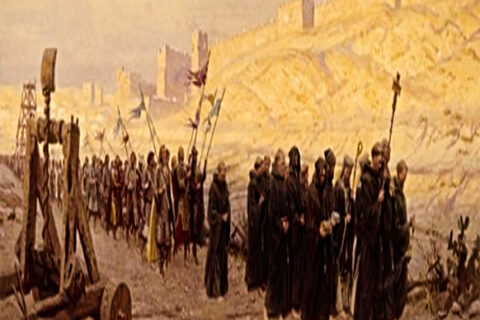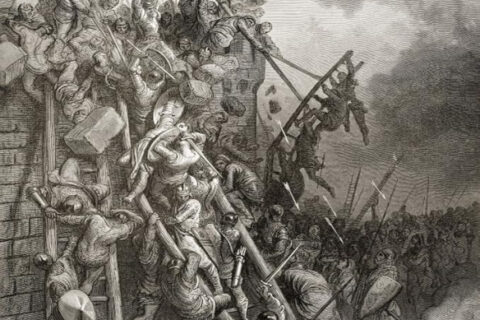My quest has been to correct some of the many misconceptions modern people have regarding the Middle Ages. We are “missing” the mark when it comes to a historical understanding of this period. I began by focusing primarily on the political system[1] and then looked at the Inquisition.[2] I have done what I could on these topics, but misconceptions regarding other issues remain, none more critical than the Crusades.
Unlike the Inquisition, the Crusades were a true medieval phenomenon. They were multi-national events during the latter half of the “Christendom” period from 700-1300 A.D. However, after the Third Crusade failed to recapture Jerusalem in 1192 and what is generally viewed as the disastrous Fourth Crusade (1202-1204), where the Latins attacked Christian Constantinople, the enthusiasm for Crusading diminished. Subsequent Crusades were usually initiated by a “crusading Pope” in collaboration with a single, often French king. Even when the (excommunicated at the time) Holy Roman Emperor Frederick II negotiated the return of Jerusalem to Latin control in 1229, it failed to reignite interest. Continual expense and loss of life for what often seemed little return, as well as increased nationalism and greater focus on domestic concerns, diverted Western attention from the Holy Land to their own realms.
The term Crusader came along later; when the events took place, participants were viewed as armed pilgrims on a pilgrimage. But since the terms “crusading” and “crusaders” are in common parlance, I will use them instead of “pilgrims.” I will also focus on the first three Crusades for multiple reasons.[3] For one, they are those most familiar to the general public; even people who have not read a single book about medieval Europe recognize names like Saladin, Richard the Lionheart, and Godfrey of Bouillon; they have heard mention of Pope Urban II’s speech at Clermont and the slaughter of Muslims and Jews after the capture of the Holy City of Jerusalem in 1099. They might even be familiar with the panic that struck Christendom after the fall of Edessa.
But also, though not the only crusades occurring during the Middle Ages, being between 1096 and 1192 they fall within the period I view as the “pure” Middle Ages,[4] and, as mentioned above, they were the combined effort of multiple realms across feudal Europe. Many lords, knights, military men, and pilgrims traveled long distances to the Holy Land during this period, often led by mighty lords and church officials. The church officials, lords, and laymen invested considerable blood and treasure to achieve something they deemed worth dying for. In other words, crusading was part of the Medieval mindset.
Nevertheless, the Crusades never had universal support. For example, many objected to crusading at the time simply because it was a new and novel idea – others thought those taking part mad; the Bavarian abbot Ekkehard of Aura documented that while leaving, the Crusaders “were viewed by them with contempt as persons who had altogether lost their wits.”[5] The vast majority of Westerners did not participate in the Crusades. At least 85% of knights never went, and a far higher percentage of the lower ranks of society.[6] The crusading ideal was unpopular in vast regions of Europe; the people who traveled east overwhelmingly came from the same local areas.
This series of articles on the Crusades will cover numerous misconceptions about the events; as Steve Weidenkopf wrote, “Many people in today’s society believe the false history presented by critics, influenced by the media, Hollywood, and other outlets. Popular perception of historical events reigns supreme even when that perception is completely at odds with historical reality.”[7] In these early articles, we will be looking at their motivations. What could cause people to risk their lives and leave their family and friends behind to travel halfway across the world? Was it lust for land and money? For power? Sheer love of fighting? Religious devotion? Self-sacrificial love? Protecting the vulnerable? Something else, or some or all of the above?
Self-Preservation
“[T]he Crusades to the East were in every way defensive wars. They were a direct response to Muslim aggression—an attempt to turn back or defend against Muslim conquests of Christian lands… That is what gave birth to the Crusades. They were not the brainchild of an ambitious pope or rapacious knights but a response to more than four centuries of conquests in which Muslims had already captured two-thirds of the old Christian world. At some point, Christianity as a faith and a culture had to defend itself or be subsumed by Islam. The Crusades were that defense.”
Thomas Madden, The Real History of the Crusades
“The Crusades were born from the violent aggression of Islam… The invasion of Christian territory, Muslim persecution of native Christians and pilgrims, plus the threat posed to the Christian Byzantine Empire, were all legitimate reasons to engage in defensive warfare and Pope Urban II cited them as justification for the First Crusade.”
Steve Weidenkopf, The Glory of the Crusades
Modern retellings of the Crusades imply bloodthirsty Christian warriors who turned from the peaceful teaching of Christ and grabbed the battleaxe, seeking the conquest and destruction of others, converting the world through force. The truth is that for hundreds of years there was an expansionist society, conquering new territories to bring everyone under the control of their religion. They converted by the sword, persecuted, and terrorized. But this society was not Christendom, it was Islam. It is wishful thinking for moderns to assume that Christendom could play nice, preach diversity and tolerance, and expect a corresponding response. Hundreds of years of history, the actions and words of Muslims, and the teaching of the Qur’an and hadiths proved the opposite.
For centuries, Islam showed it would continue to expand and to subjugate or eradicate other cultures, conquering territories previously under Christian rule, including Egypt and the rest of North Africa, Syria, Palestine, Cyprus, the bulk of Iberia, Anatolia, Armenia, Sicily and eventually much of the Balkans and further into Central Europe. During the ninth century, Muslim forces attacked Rome and pillaged Christian churches, and in the 11th destroyed the Church of the Holy Sepulcher in Jerusalem.[8] Medieval scholar Christopher Tyerman wrote, “The memory of the long struggle with Islam from the 7th century was not lost 400 years later. If anything, it had grown.”[9]
Medieval scholar Professor Thomas Madden wrote that the Crusaders directly resulted from the “Muslim conquest of Christian territories.”[10] Professor Rodney Stark explained that Urban II and the Crusaders did not embark on a conquest but rather viewed it as an armed pilgrimage to visit the Holy Land and return. They aimed to recover ancient Christian territory in a just and defensive war. He wrote, “Heroic men and women of faith, rooted in love of Christ and neighbor, undertook the Crusades as acts of self-defense and recovery of stolen property. This is the proper understanding of these important events in Church history.”[11]
In the same way, if any pagan peoples invaded, Christians defended themselves against the ruin of their homes, religion, and culture. Over half of Christendom had already been conquered when a response (the First Crusade) was called.[12] The Gospel and God’s laws were too vital to be allowed to be wiped off the earth; they had to act.[13]
The Crusades were not offensive but defensive minded; when a crusader force besieged Lisbon the Archbishop of Braga said “You have held our cities and lands already for 358 years. Return to the homeland of the Moors whence you came, leaving to us what is ours.”[14] The crusading period put Islam on the defensive and began to restore regions that were formerly Christian to the faith. And when the crusading fervor ended, Islam once more went on the offensive, capturing Constantinople, overwhelming the Balkan kingdoms and pushing into Hungary.
Perhaps an imagined modern scenario might help us understand why Europe was prepared to arm itself for war against the rise of Islam. What if an armed mob of antifa invaded North Carolina, forced people to consume their propaganda, burned down churches, raped, enforced their beliefs, harassed or killed anyone who tried to protest or speak out against the injustice, and promised to expand into all of the South. What if this occurred for hundreds of years? Would not the government and the people themselves call for military action to restore North Carolina? And would they not feel justified in military action? One culture might define evil in its own way, but we would react against it just the same if what we cherished was under assault, as it was to those people in medieval Europe. The extensive time the Church and West sat allowing persecution should not surprise us; its patience, tolerance, and so on were part of the “just war” theory of Saint Agustine and the Church.
A just war must be reactive and defensive and eradicate a more severe evil than the war itself would bring. Thus, something like massive persecution over time and in the future must finally cause a war to be called.
[1] (Smith and Hedberg Jr. 2024)
[2] (Smith 2023)
[3] Focusing mainly on the First Crusade, its origins, purposes, etc., as the latter two were attempts to restore what the first had accomplished.
[4] From 700-1300 A.D. For why the 14th century transformed Europe from medieval to early modern, see my book Missing Monarchy: Correcting Misconceptions About The Middle Ages, Medieval Kingship, Democracy, And Liberty.
[5] (Ekkehard of Aura)
[6] (Stark 2010 114)
[7] (Weidenkopf 2014 17)
[8] (Stark 2017 97)(Durant and Durant 290)(Weidenkopf 2014 34)
[9] (Tyerman) (FLICK, Ph. D., Litt. D 483)
[10] (Madden 2005 4)
[11] (Stark 2017
[12] (Madden 2005 213, 223)(Stark 2010 9)(Weidenkopf 2014 31, 96)
[13] (Weidenkopf 2014 207)
[14] (Carroll 1993, 63-64)

Jeb Smith is the author of four books, the most recent being Missing Monarchy: Correcting Misconceptions About The Middle Ages, Medieval Kingship, Democracy, And Liberty. Before that, he published The Road Goes Ever On and On: A New Perspective on J. R. R. Tolkien and Middle-earth and also authored Defending Dixie’s Land: What Every American Should Know About The South And The Civil War, written under the name Isaac C. Bishop. Smith has authored dozens of articles in various publications, including History is Now Magazine, The Postil Magazine, Medieval History, Medieval Magazine, and Fellowship & Fairydust and featured on various podcasts including The Lepanto Institute.






“A just war must be reactive and defensive and eradicate a more severe evil than the war itself would bring.”
Amen to that!
I was taught Augustine’s just war theory, but have since expanded my understanding to include the idea that a preventive-offensive war can also be included under just war theory. Stonewall Jackson favored capitalizing on the advantage gained at First Manassas by taking the offensive to proceed on to Washington DC and conquer a peace. Unfortunately, President Davis nixed the suggestion. We can debate whether or not it would have succeeded, but I think Jackson understood that Yankee aims weren’t going to be receptive to compromise or a negotiated peace.
I would have to think more on that but…..I do think that could fit within just war theory.
That is one of the big “what if” for the South. I would have loved an early end to the war. With the South free of course.
The Romania Orthodox Church during this time period defended and keep Europe safe from Muslim raids.
Looking forward to your series Sir,
Oh yeah this is gonna be a good series
Jeb Smith.
” when a crusader force besieged Lisbon……..’
Can you tell me where you gleaned that information? Is there a book on it by any chance? I see it says Carroll 1993 on your 14th reference, did I miss the name of the book somehow?
Thank you.
God Bless You Sir.
Thank you for your interest. I believe the editors will include the biography with the last article in the series. But i pulled the quote from this book
The Glory of Christendom, 1100-1517: A History of Christendom (vol. 3) (Volume 3) (History of Christendom Series ; Vol. III)
https://www.amazon.com/Glory-Christendom-1100-1517-History-vol/dp/0931888549
Thank you Mr. Smith.
Portugal wrested the spice trade from the Muslims in the age of discovery, and brought Christs Kingdom to the Orient and the new world during the counter-reformation. It was a crusade of sorts. Holland and the Dutch East India company fought Portugal in Japan in 1602, to spread the newly formed stock market system, some would say that it was the start of world war 1.
I trace part of my heritage to Lusitana.
Thank you again for your reply Sir.
Looking forward to the rest of your series on the Crusades.